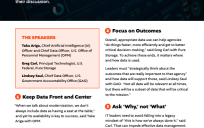As diversity, equity, inclusion, and accessibility (DEIA) initiatives have grown in importance across the public and private sectors, new attention is being paid to MD-715, a policy directive issued by the U.S. Equal Employment Opportunity Commission (EEOC) that provides federal agencies with guidelines for establishing and maintaining effective Equal Employment Opportunity (EEO) programs.

Issued in 2003, MD-715 is officially titled “Model Agency Plan for Providing Employment Opportunity for Individuals with Disabilities,” yet over the past two decades, it has been revised to reflect modern workforce management principles around broader equity and inclusion.
Today, MD-715 serves as a roadmap helping federal agencies create and maintain inclusive workplaces. Its primary objective, in combination with the No Fear Act, is to hold federal agencies accountable for any violations of discrimination or retaliation.
In this article, we will examine MD-715, discussing its purpose, components, and real-world impact, while spotlighting how it empowers agencies to establish model EEO programs and uphold the principles the No Fear Act.
6 Key Elements of MD-715 Programs
MD-715 isn’t just bureaucratic jargon. It’s a roadmap for creating workplaces where fairness prevails, and talent thrives. Here are six key elements of MD-715 that make it so effective.
- Leadership Commitment: For each agency to have a successful EEO Program, it must first demonstrate commitment from the agency’s leadership. This commitment is captured in an agency statement, which must be posted and shared throughout the agency. It is then evaluated by unions through a MD-715 checklist to gauge the agency’s compliance and commitment to accountability.
- Appointing an EEO Director: Agency leadership must appoint an EEO Director who will have a direct reporting line to the agency’s top executive. The EEO Director assumes overall responsibility for administering a program that facilitates timely counseling, investigations, and final agency actions, (all conducted in accordance with the guidelines outlined in 29 CFR 1614 for complaint processing). Annually, the EEO Director is tasked with evaluating the EEO program and offering suggestions for enhancement to the agency’s leadership.
- Program Accountability: EEOC provides instructions for the agency to perform routine internal audits of its divisions, aimed at pinpointing shortcomings and gauging the agency’s success in eliminating obstacles. The EEOC mandates agencies to formulate an all-encompassing anti-harassment policy to proactively prevent and tackle harassment. Additionally, agencies are obligated to create viable procedures for reasonable accommodations to uphold adherence to EEOC regulations and directives along with compliance with executive orders, guidelines, and benchmarks.
- Self-Assessment and Data Collection: Agencies are obligated to conduct an annual self-assessment to look for ways to be proactive about preventing unlawful discrimination throughout the agency. This self-assessment is required to identify potential barriers that could result in the exclusion of specific groups and to formulate strategic plans for the elimination of these identified barriers. Agencies conduct a workforce analysis and a barriers analysis to examine demographic data related to employees at all levels and to assess policies and practices that may prove to be barriers to equity.
- Proactive Programming and Policymaking: Based on the findings from the workforce and barrier analyses, agencies must develop and implement action-oriented programs (AOPs). These programs are designed to address the identified barriers and enhance diversity and inclusivity within the organization. AOPs may include recruitment and retention strategies, training programs, mentoring initiatives, and outreach efforts to underrepresented communities.
- Effectiveness and Compliance: Each year, the EEO programs in place are evaluated through the reporting process for efficiency and fairness of the dispute resolution process in the agency. By evaluating the program’s overall performance as well as benchmarking it to other agencies, an agency can get a sense of its level of compliance, receives more data to evaluate its programming effectiveness, and ultimately will have a roadmap to guide the implementation of new programming.
Challenges and Future Outlook
While MD-715 has undoubtedly made significant strides in promoting equal employment opportunities, challenges still exist.
Some agencies may struggle with the implementation of action-oriented programs due to resource constraints or resistance to change. Additionally, measuring the true impact of these programs on workplace diversity and inclusivity can be complex, especially when manually creating this annual report.
Looking ahead, the future of MD-715 lies in its adaptability to changing workforce dynamics and the tools that help produce MD-715 data for better insight. Regular reviews and updates to MD-715 will be essential to ensure its continued effectiveness in holding agencies accountable to data-driven programs that result in equity and fairness.
Russell Miller is Director of Implementation for Government Workforce Management, at OPEXUS. He has extensive experience providing implementation support for the HR Product Suite at OPEXUS. His expertise helps ensure products are delivered on time and on budget. He is passionate about using technology to improve the day-to-day functionality across government HR processes. In his free time, Russ enjoys Boston’s sport events, boating, and spending time with his family.





Leave a Reply
You must be logged in to post a comment.